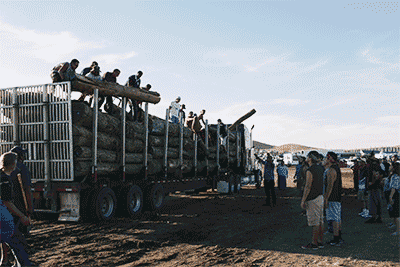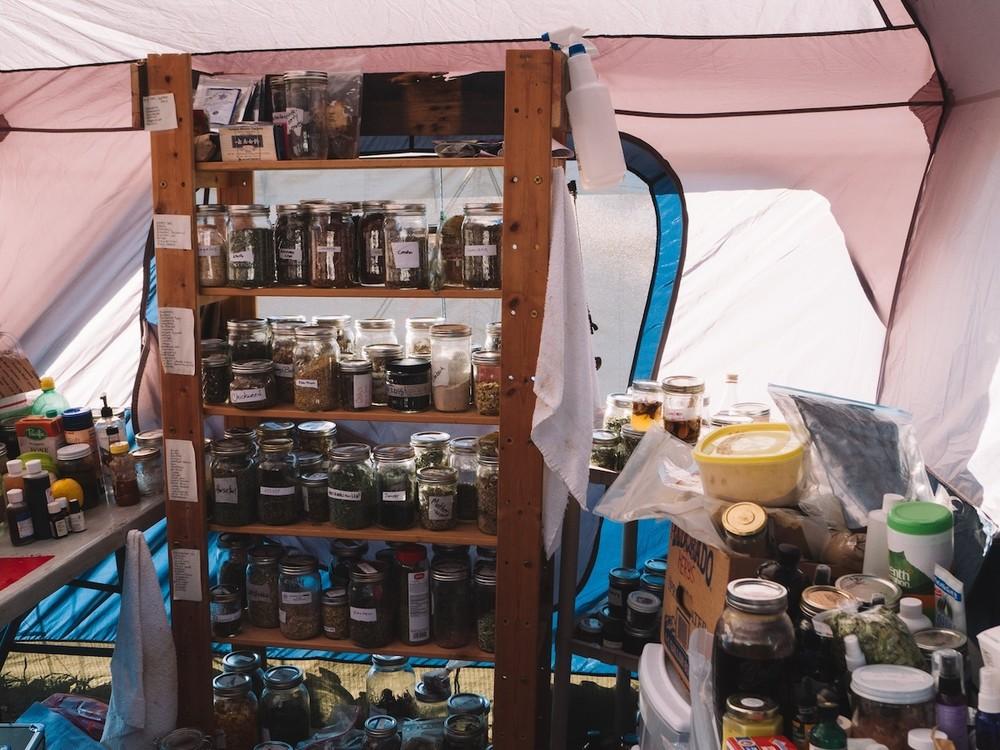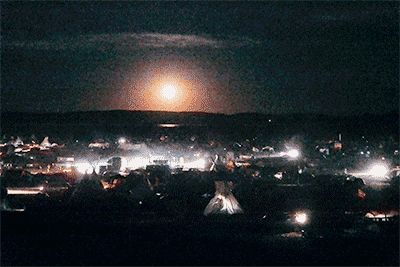Driving to the camp at the Standing Rock Reservation in North Dakota, where Native American activists have been living in order to halt the construction of the Bakken Pipeline for months, you come across everything all at once: the field dotted with tipis, trailers, and tents; the mud roads lined with flags from dozens of tribal nations flapping in the wind; people riding horses and trucks laden with supplies.
The activists are here to fight a major pipeline that they say will poison their drinking water and pollute tribal lands that have long been held sacred. They won a big victory earlier this month when the Army Corps of Engineers ordered a halt to construction on the pipeline while it reconsidered the matter. But the project has not been canceled and people at Standing Rock know that the fight is far from over; this week, Standing Rock chairman Dave Archambault II went to Geneva to appeal to the United Nations Human Rights Council. The people encamped here have no intention of leaving, even as winter slowly but inexorably approaches.
Videos by VICE
To the south, on the Standing Rock reservation itself, is the Camp of Sacred Stone, the original camp, which was established in April. Farther north is an area referred to as the “front lines.” where the most heated actions against the pipeline occur. But in between the two areas, where Cannonball River flows into the Missouri River, is a much larger camp. This area, which goes by a variety of names such as “the main camp” or “overflow camp,” is on a large field at the bottom of a hill. The geographic features surrounding it makes it virtually invisible from Highway 1806, but as you pass the hills, it becomes impossible to miss.
When I arrived at the camp’s center, I found it bustling with activity. Volunteers prepped food, tended to the ill or wounded, and sorted through donations. Children ran about as a speaker with a microphone made community announcements. People lined up at screen-printing stalls to add activist flair to their T-shirts. There is a board for rideshares where people offer or seek rides to and from camps, some going as far as Sacramento.


All photos and GIFs by the author
Cell service is spotty here—the only place with service is a grassy hill humorously dubbed “Facebook Hill.” Here you can find the media tent and the camp’s radio station, Spirit Resistance Radio, which broadcasts locally on FM 89.7 and streams on Twitch. The station is run out of a tent, operates off a combination of wind and solar power and reaches the airwaves through an antenna attached to a large pole.
Except for a brief visit to Sacred Stone, I spent most of my time at this larger camp. As I wandered for two days, I spoke with people and learned about what brought them out to Standing Rock. Here’s what they had to say.

Paulino Mejia, an activist from Fort Lauderdale, Florida
There’s so much wisdom here. Our elders are seeing one another. People like me have the opportunity to talk to our elders that we’ve never had before. It’s truly so much wisdom and loving and caring. Everyone is looking out for one another; everyone is learning from one another. Everyone is coming together, to fight for water, that all life on earth needs.
Out here you don’t get too much cell service. Almost like a detox from all these things that constantly bombard our people… The drugs and alcohol that affect our people, those aren’t allowed in this space. It’s a break from these things that have been used to colonize for generations. So it’s nice, you know?
A few days ago, they announced that they needed two-spirits (a Native term for people who have both masculine and feminine spirits inside them) in the kitchen, and my friend put me on blast, and ever since I’ve been cooking a lot. In the kitchen, you need people cutting, you need fire keepers, which are some of the most sacred in the community. You need people to chop wood, people to season, people to cook, people to organize, people to serve. In the community, we have people out of their own hearts picking up garbage. People driving around in cars with logs, so everyone can have access to firewood. Some guy the other day was driving around passing out water. The Sioux made a big buffalo soup, and they gave it to me and said, “Go around to the different nations and see who wants it!” So you’ll see people more organized, and people just walking around helping people in any way they can.

Philip Bird Horse, a horsemanship associate at Sitting Bull College in Fort Yates, North Dakota
We camp every weekend. On Sundays, we head back home and go to work till Thursday night, pack up, and bring the horses back up. We’ve been giving a lot of people horse rides, a lot of people have never had the opportunity to touch a horse before.
It’s good to see all of the support that is here. Last week, they said there are more than 240 tribes represented here. It’s a great cause. It’s the first time in history that so many of us could come together like this. All for water. This water is life. Our horses, our cattle, our crops, all use this water.

Joseph Shotridge, a carpenter from Eugene, Oregon
I’m here for my people! This isn’t my people’s land, but my people being the indigenous of Americas, North and South. It was time to unify—time to stand up together.
This is my second time here. I came a month ago. I didn’t even intend on coming back. I got a phone call at 9:30 AM; my eighth-grade principal actually called me up, and she was like, “I’m on my way out the door, right now.” And I was like, “Well, I’m doing my laundry from the last time I was there, let me finish folding, and I’ll grab my tent, let’s go!”
So we loaded up a van and came out here. I’m here for the long haul. Right now, I’m just trying to help out. I want to make sure my mom is warm when she gets here. We’re waiting on lumber, we’re waiting on building materials, and we’re going to start building winter shelters. I’ve swung a hammer since I was 17. I was talking with the women council up there, and they asked what kind of suggestions I had for this, and the first thing I had to say was, “Talk to the youth council, get these youth out there and keep them busy, teach ’em something.”

Tori Cress, the social media manager of the Toronto chapter of Idle No More, a group led by indigenous women
Cress has spent the summer on a “toxic water tour,” bringing attention to all the different water disasters happening across the continent. We met on Facebook Hill, where I found her streaming a message to the followers of Idle No More.
I specifically came here with a friend, so we can raise women’s, two-spirit, and transgender voices because these are the voices that are not coming out of the camp, and these are people who are here. Where I’m from, we have mainly been seeing men talking, and women have a voice, we want to raise their voices up to have their stories told, because their stories are just as significant. This is a water issue.
I’m the mother of a transgender son. I don’t know how it is to be transgender, but I can see the pain that he’s been in. I don’t know how other people deal with it—my son’s got a healthy, happy home to be himself in, but not everybody has that. Having those safe spaces for everyone is important.
I got here today, and I’m gonna find it really difficult to leave already. You really feel a lot of camaraderie—people showing us the ropes and telling us what, when, and where. Seeing that happen is inspirational. I don’t want to discourage anybody in our audience to come down here. I want people to come learn how to hold the land.

The inside of Bugs’s medic tent
Bugs, a holistic health practitioner working in one of the camp’s medic tents
We’re basically busy from the second the sun rises till midnight. Even at seven in the morning, this area was full of people to help. I’ve been here for about five days. We’re nurturing people. We’re here with more holistic stuff, next door there’s first aid, and there’s healers of other modalities spread throughout the camp.
We really need a yurt! Like, a big enough yurt to house supplies and space to treat people, and as winter comes, we need a stronger space to handle the wind and cold. We’re working toward increasing our infrastructure for winter, so our wellness space can be its best. We’re also looking for herbal donations. We need nutritious stuff, shatavari, schisandra, licorice, shiitakes, good nutritious mushrooms—just to have stuff on hand to help the people working really hard and exposed to weather.

Nathaniel Fuentes, a film student at the Institute of American Indian Arts (IA) in Santa Fe
I’m documenting my trip to show what life is really like in the camp. There’s no drugs, there’s no alcohol, there’s no weapons. It’s a peaceful camp, and it’s a camp of unity. I’m part of a group of students from IA who came up, and we brought donations and supplies in a couple vanloads. We’re also conducting workshops and activities to help stimulate unity—also to bring more awareness to the situation.

A view of Standing Rock at night
We’re running into all kinds of people who have connections to one another here. I met a few people yesterday who are connected with family members, with close friends. People who I’ve never met before, but we have that common link, and that’s another reason why all us indigenous people here see one another as family. We see one another as family, as brothers, as sisters, as aunts, as uncles, as fathers, as mothers, grandfathers, grandmothers. We’re all connected in that way.

Bert Malcom, a musician from Pine Ridge, South Dakota
Malcom* was adopted by a Jewish family in Nebraska at a young age as part of a movement to take native children off reservations. He later set off on a journey to South Dakota find his native family.
I guess when I was 17, I just got a bus ticket and took off to South Dakota to re-find my family, you know? I found them, I tracked them all down, found my little brother, found my little sister, found where they were. I went to Qdoba’s [where my sister worked] every single day asking to talk to a manager. They finally got annoyed, and I got in contact with them. We met downtown, and I saw my sister for the first time since she was two years old. She had just turned 13. I hadn’t had contact with her since she was a baby. Last time I’d seen her she hadn’t even said a word. I lost contact with all my siblings in an environment where I felt alone. Where I felt like nobody would ever understand me.
I feel like everything was worth it. At first, I was the only native Jewish person in town.
The whole culture is about taking care of the land. People here grow up their whole lives learning how to recycle, to compost, that’s how it needs to be. We’re always learning, too. Everyone is always learning new ways to take care.
*Correction: An earlier version of this article misspelled Bert Malcom’s name.
Sofia Lee is a photographer and GIF animator and makes GIFs for Seattle Weekly.
More
From VICE
-

Collage by VICE -

Collage by VICE -

Collage by VICE -

Eva Pascoe, founder of Cyberia, poses at the cyber cafe in London. All photos courtesy of Eva Pascoe, Ali Knapp, and Roger Green.
